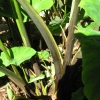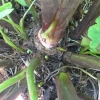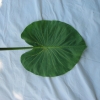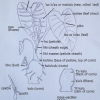Use As Food
A fair table taro.
Distribution
Found occasionally under upland culture, where temperatures are cooler, in Puna, Hawai‘i.
General Characteristics
Short to medium in height, moderately spreading, maturing within 9 to 12 months, producing from 5 to 10 ‘ohā; characterized by whitish ‘i‘o kalo (Corm) flesh and purplish-black Hā (Petiole) shading into yellowish-green at apex, with red lihi (stem edges).
Ha (Petiole)
55 to 75 cm, long, purplish.black shading into yellowish.green at the top (apex), red at the lihi (stems edge), a dark pink ring at kōhina (base) with light pink for 3 to 4 cm. above the base.
Lau or Lu'au(Leaf Blade)
35 to 45 cm. long, 30 to 35 cm. wide, 30 to 35 cm. from tip to base of sinus (māwae), egg-shaped (ovate), fairly firm in texture, dark green; piko light yellowish to light brownish; round leaf section (lobes) acute with deep, wide lihi māwae (sinus).
'I'o kalo (Corm)
Flesh white with light pinkish tinge, especially near apex, and yellowish fibers; skin pink.
Pua (Flower)
Hā (peduncle) light yellowish-green with brownish flecking at kōhina (base); flower cover (spathe) 18 to 23 cm. long, the lower tubular portion 3 to 4 cm. long, light green tinged with purple at kōhina (base), loosely rolled and sometimes slightly open, the upper portion clear deep yellow, open near constriction (skinny part of flower).
Remarks














